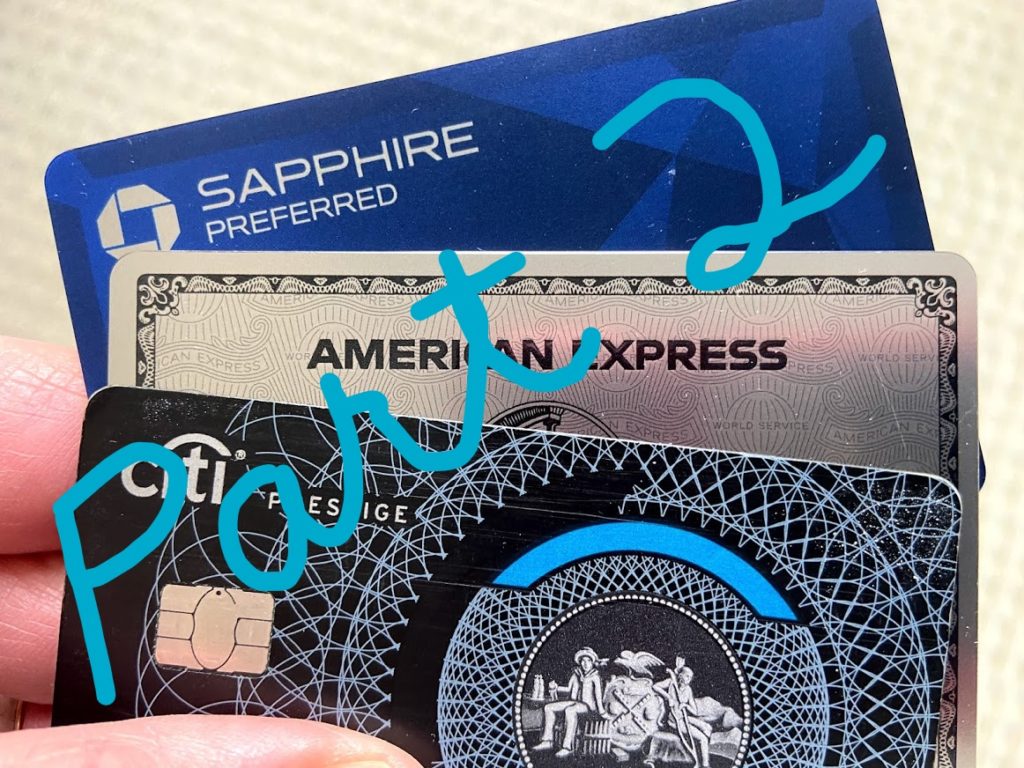Continuing the discussion about Unique Currency (UC) cards. . .for another user’s point of view, I’m turning this post over to Dave Castro, a Certified Financial Planner, fellow Exceptional Traveler and, most importantly, son-in-law! Here is Dave’s game plan for maximizing points:
After playing the credit card points game for the past 10 years or so, I’ve learned that it pays to keep things simple. While I don’t fault anyone who values the ornately structured wallet of cards for any and every spending occasion, optimized to perfection, I personally don’t enjoy spending time sorting through which card or which points currency I need to use every time I make a purchase decision. I want to know in a matter of seconds which card is best, ideally choosing from only a handful, and also have all of my cards accumulate points in the same UC.
Enter the Chase ecosystem. The best part of this grouping of cards is that you’ll have one login and one points currency. It keeps things simple. I currently utilize the Chase Freedom Unlimited, Chase Sapphire Reserve and Chase Freedom card – each for a specific set of reasons. All cards earn points in the “Ultimate Rewards” currency, and all points are transferrable between the cards. That said, you get the most redemption value leverage by redeeming points through the Sapphire Reserve card, so that means all points get moved to Sapphire as earned. Collecting everything in one “pile” helps to simplify things.
In terms of earning, I use the Sapphire Reserve card for travel (airfare, Uber, rental cars) and restaurants, and pretty much nothing else. These specific categories earn 3X points. For most other purchases, I use the Chase Freedom Unlimited card, which earns 1.5X points, no matter the category. The Chase Freedom (not Unlimited) card has rotating categories each quarter, on which you earn 5X points. The downside is that you have to track which category the card is offering 5X points for at any particular point in time – otherwise you earn only 1X points on every other purchase. While a mild annoyance, the transferability to Sapphire Reserve and the redemption leverage therein makes it worth tracking those 5X categories and using this card for those charges only.
Once points have begun to accumulate, I transfer all points to my Sapphire account (which is an easy online process). Then, I use the points almost exclusively for travel expenses, which is where I’ve been able to extract the most value. Sapphire points are at a minimum worth 1.5 cents apiece when you purchase flights or hotels using the Sapphire Ultimate Rewards portal. It’s basically identical to using Expedia, but with points as your currency instead of cash (the portal platform itself was developed by Expedia).
While redeeming points through the Chase portal is always a good “baseline” use of points, I’ve often found that transferring directly to hotel partners or airlines can leverage much higher point values than settling for the portal. One example is through Hyatt: Ultimate Rewards points transfer to the World of Hyatt program on a 1:1 basis, and, depending on the cash price of the room stay, I’ve been able to extract values upwards of 7 cents per point (!) for certain stays, like the Hyatt Ventana Big Sur in California, where we’ll be vacationing this summer. This equates to an earnings rate of 10% for the Freedom unlimited card (1.5x points on spend), 21% for the Sapphire (3x spend) and an unheard-of 35% return for spend on the Chase Freedom card (5x).
We like Dave’s solid, simple approach that maximizes his earnings potential. Note that if you set about to construct the same portfolio of cards today, the Chase Freedom card is no longer available. Taking its place in the Chase galaxy of cards is the Chase Freedom Flex card, offering the same rolling 5X quarterly categories. Another important factor to take into account is that Chase has a policy in place. . .that they refuse to confirm, but certainly does exist. . .that limits the number of new personal credit cards any individual can open with them. It’s called the 5/24 rule, and it basically caps new personal cards to those applicants that have opened less than five cards. . .from ANY issuer. . .in the previous 24 months. That includes an additional user card that your wonderful spouse (like Mrs. E) might give you for her new credit card account. Bottom line here is that if you decide that Ultimate Rewards are the UC for you, get those Chase cards first, before applying for any others. For more info on the 5/24 rule, click here.

You can construct an even simpler approach if you decide that the American Express Membership Rewards program partners are better suited to your travel habits. We would recommend just two cards: the American Express Gold card and the Amex EveryDay Preferred Credit card. The only reason you would want the EveryDay Preferred card is if you have more than 30 separate charges each billing period (not including restaurant or airline charges). If you do, the points earning multiples increase by 50%. Assuming that you would exceed the 30 transaction rule, your plan would be to charge restaurant (4X) and airline charges (3X) to the Gold card and everything else to the EveryDay Preferred card, where you would earn 4.5X on supermarket charges, 3X on gas station charges, and 1.5X on everything else. The current sign-up bonuses would jumpstart your Membership Rewards point accounts by 70,000 and 15,000 points respectively, for a total of 85,000 points. That could easily pay for a round trip flight to Europe or the Caribbean plus a few hotel nights.
To summarize, you should construct your game plan by first reviewing the transfer partners of each of the UC programs. Pick the one that has the most providers that you would use. Next, take a look at the available cards for that program, and select the ones that give you the highest points earning potential. Factor in your ability to spend enough to earn that card’s sign-up bonus, and then apply for the card or cards that make sense for you. You will be on your way to maximizing your earned points, and free travel will be coming your way. . .as soon as we can safely travel again.
Do you have a different game plan for your cards? Or do you have questions about how the cards you already own can work best together? If so, leave a comment below. . .sharing your approach with the TET community benefits us all, and we’re happy to give you our insights and suggestions.

Santorini sunset


Pingback: Which Card is Right for You? P&M 201 - theexceptionaltraveler.com